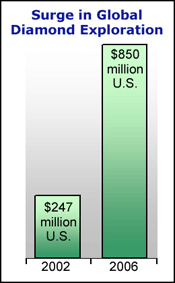Profit from the Surge in Global Diamond Demand and Exploration
Commodities / Diamonds Nov 28, 2007 - 08:37 AM GMT  Sean Brodrick writes: The price of polished diamonds is rising at a rate of about 10% year over year, and the falling dollar could accelerate that surge. However, most diamond mining and exploration stocks haven't joined the rally in natural resource stocks over the past 12 months.
Sean Brodrick writes: The price of polished diamonds is rising at a rate of about 10% year over year, and the falling dollar could accelerate that surge. However, most diamond mining and exploration stocks haven't joined the rally in natural resource stocks over the past 12 months.
Together, I think those two facts mean there is the potential for significant upside in diamond stocks, a move that could come at a dizzying speed. And that's why I've been doing a ton of research on the industry, building on my trip to an Arctic diamond camp this past August.
I'll tell you more about the profit potential in diamonds in a moment. First, I want to tell you how the diamond craze got started. It all begins with ...
The World's Greatest Unknown Explorer and the King of Bling!
Louis the XIV ascended to the French throne and became the Sun King in 1643. Because of his love of diamonds, a better name for him might be "The King of Bling."
Louis' love of diamonds made him an odd duck in the fashion world of the time. In the 1600s, and for centuries before that, Europe's high and mighty didn't want diamonds — they wanted pearls. In fact, when Christopher Columbus went to the New World, pearls were on the top of Queen Isabella's wish list — way ahead of gold and silver (diamonds didn't even make the list).
 |
| Louis XIV was a real trendsetter! |
But Louis the XIV was having none of that. He was dazzled by diamonds, which were incredibly rare in those days. This was before diamonds were discovered in Brazil or South Africa, when the world's diamonds came from the river sediments of the Golconda region of India.
Luckily for Louis, an intrepid explorer came along. His name was Jean-Baptiste Tavernier, and he's the greatest explorer you never heard of. A professional jeweler by trade, he was obsessed with diamonds and he knew they came from India. So, he traveled, over land and sea, to far Constantinople, then through Persia, then on to India. He visited the court of the Great Mogul Emperor, who ruled the legendary Kollur diamond mine.
In his book Travels in India , Tavernier describes the Emperor's court:
"In the middle of this hall, and near the side overlooking the court, as in a theatre, they place the throne when the Emperor comes to give audience and administer justice. It is a small bed of the size of our camp beds, with its four columns, the canopy, the back, a bolster, and counterpane; all of which are covered with diamonds."
Tavernier went on to the Golconda region, to the fortress of the same name, the center of India's diamond activity. There, 60,000 slaves — men, women and children — dug through sediments in a never-ending quest for diamonds.
Thievery was a problem, so the Moguls kept their workers dressed only in loincloths and any thief was severely punished. Tavernier saw one thief get his eye gouged out with the purloined rock.
And what rocks they dug out of the Golconda mud! The Golconda diamonds were prized for their size and beauty, and they include some of the world's most famous diamonds: the Hope Diamond, the Orlov Diamond, the Darya-i-Nur Diamond, and the Koh-i-Noor Diamond. Tavernier relates handling a diamond that was 900 carats (a carat is a fifth of a gram)!

Tavernier did what any enterprising merchant would do. He traded ornate European goldwork for all the diamonds he could carry and went back to France, arriving in 1668. And guess who his best customer was? That's right — Louis, the King of Bling.
Louis spent the equivalent of $75 million to buy 1,200 of Tavernier's "regular" stones (between eight and 12 carats apiece) and 44 really large rocks. The biggest stone that Louis bought from Tavernier was a stunning blue-tinted diamond weighing 111 carats. Louis liked it so much he used to hang it from a ribbon around his neck just to flash it at guests. This was one of the first diamonds to receive a "brilliant" cut, and Louis' fashion-sense paved the way for diamond lovers to this day.
You see, cutting facets into diamonds was one thing that set European jewelers apart from those in India. New technology — new for the 17th Century anyway — allowed European jewelers to cut and polish diamonds in dazzling new ways, fashioning beautiful faceted gems from those giant rough stones.
Tavernier hated seeing his diamonds cut up. But he had 75 million reasons to let Louis have his way. Besides, Louis was THE fashion-plate of the 17th and early 18th Centuries. His obsession with diamonds set the trend for the world, a trend that still continues today ...
Look to the East for the Future of Diamonds
If anything, Louis' favorite stones are more precious than ever. Here's why ...
Diamond stockpiles are down 7.5% since 2000, according to a July report from Canada's National Bank Financial. What's more, no new mines are scheduled to start production in the next three to five years, according to RBC Capital Markets.

That supply squeeze is driving prices up. Prices of five-carat polished diamonds jumped 8.4% in the first half of this year, quadruple the advance of the year-earlier period, according to National Bank Financial.
Meanwhile, demand is getting stronger. According to Harry Winston Corporation, the global luxury diamond sales leader, worldwide diamond jewelry sales rose 25% to about US$70 billion in 2006 from $55 billion in 2004.
The U.S. is the world's biggest consumer of diamonds, accounting for roughly half of world retail diamond sales.
At the same time, annual incomes in India and China, the two fastest-growing diamond markets, are rising as much as 18% a year. The effects are clear ...
China's diamond imports rose more than threefold in the first half of this year. In China, about 40% of Chinese women are now getting married with diamond rings and that trend is expected to increase significantly over the coming years.
Meanwhile, India's diamond imports increased 14% in the second quarter of this year. This is fueled by a surge in per-capita income, up 8.4% in the last fiscal year. India's diamond consumption has gained 27% annually for the past five years.
Looking ahead, the supply/demand gap in diamonds is expected to widen starting in 2008!
Again, this is mainly due to that rising demand in China and India. According to De Beers, the size of the diamond consuming market in India and China is expected to post a compounded annual growth rate of 7%. The diamond-consuming market in these two Asian countries alone is expected to DOUBLE from 33 million consumers today to 65 million consumers by 2015.
The Best News for Investors: This Is a Market You Can Play
Last week I talked about the proposed merger between BHP Billiton and Rio Tinto . Diamonds are the smallest units in each of their businesses. Nevertheless, the pooled diamond operations would cement the combined company as the third-largest diamond producer in the world behind No.1 De Beers and No.2 ALROSA.
BHP and Rio Tinto together produced 31.5 million carats of diamonds in the 12 months ending September 30, 2007, with the bulk, 27.77 million carats worth, coming from Rio Tinto's operations.
Rio has its flagship Argyle mine in Australia, a 60% stake in the Diavik operations in Canada, and a 78% share in Zimbabwe's Murowa mine. BHP would bring its 80% share in the Ekati diamond mine in Canada to the table, plus exploration projects in Canada, Angola, and the Democratic Republic of the Congo. BHP produces 4% of the world's diamonds at its Ekati mine.
Rio's stock has sold off since the merger announcement, but I believe it has a lot of upside potential. BHP may be outbid — Rio has revealed it has had calls from other parties, and there is speculation that China's $200-billion sovereign wealth fund may be among them.
Alternately, there is speculation that Rio will sell off its diamond operations if the merger goes through. If that happens, keep your eyes peeled — you might want to invest in whoever buys those assets up.
However — and this is important — you shouldn't place much value on Rio Tinto's assets in Zimbabwe. Here's why: Zimbabwe's President Mugabe is passing a law that will allow the country to grab a 51% stake in mines operating in the country. It gets worse: The law allows the state to NOT pay for 25% of the seized assets.
The Zimbabwe operation is a small part of Rio's assets, but Mugabe's naked resource grab shows the dangers of investing in the developing world, and it demonstrates why you need to do your due diligence before you make any investment.
Of course, there are also new mines coming along in Canada and Australia, both very business-friendly countries. I think some of those mines look like very good bets indeed.
Those are the kinds of companies on my short list of stocks for the Red-Hot Global Resources portfolio. I have a couple of great little diamond explorers on my radar right now, and I could pull the trigger at any minute!
Good luck and good trades,
Sean
P.S. You don't have to go all the way to India to find diamonds in the rough. If you want to get on board with my latest precious mining picks in global small caps, call 1-800-898-0819 or subscribe online .
This investment news is brought to you by Money and Markets . Money and Markets is a free daily investment newsletter from Martin D. Weiss and Weiss Research analysts offering the latest investing news and financial insights for the stock market, including tips and advice on investing in gold, energy and oil. Dr. Weiss is a leader in the fields of investing, interest rates, financial safety and economic forecasting. To view archives or subscribe, visit http://www.moneyandmarkets.com .
Money and Markets Archive |
© 2005-2022 http://www.MarketOracle.co.uk - The Market Oracle is a FREE Daily Financial Markets Analysis & Forecasting online publication.



